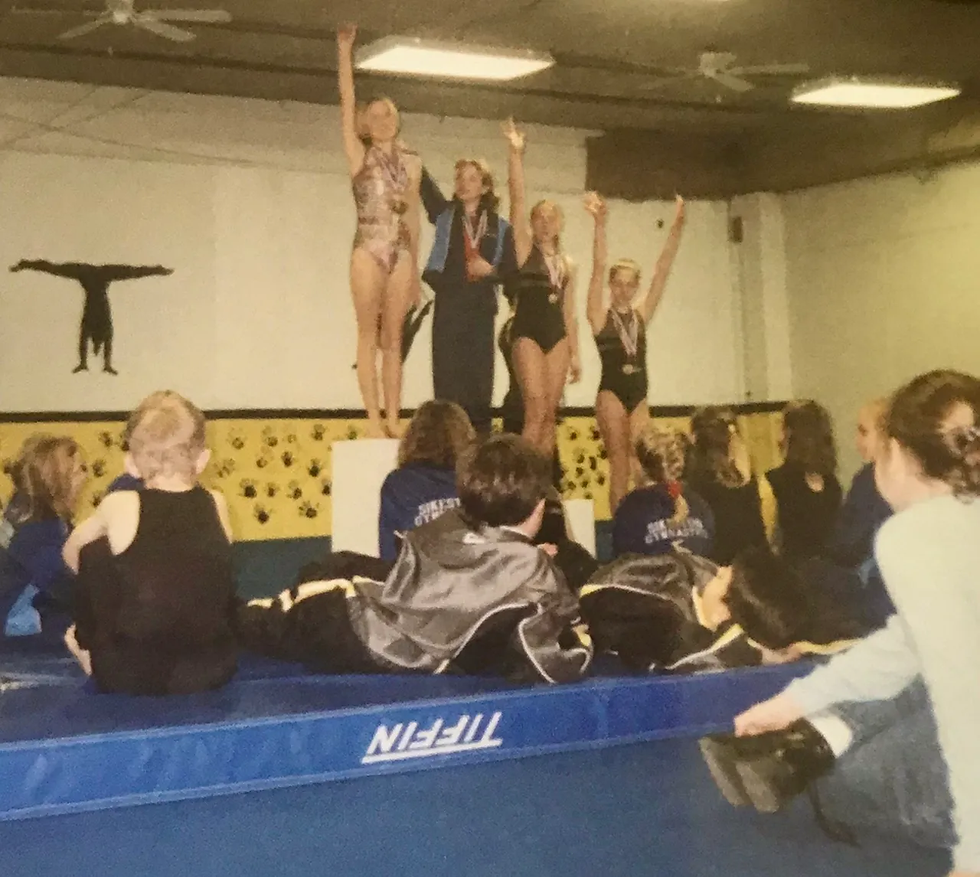Watching Olympic Gymnastics As A Former Gymnast
- Liz

- Aug 4
- 4 min read
Updated: Sep 6

It’s the 1990s and I’ve just wrecked my bike. I’m scraped up and I’ll have bruises later, but I don’t care about that. All I care about is finding the Olympic gymnast McDonald’s Happy Meal toy that was riding in my basket. She’s blonde with blue eyes. She’s dressed in red, white, and blue. My hero is Dominique Dawes, but I treasure the tiny, plastic Olympian who looks so much like me. I search the hillside for her as long as I can stand it. I search the ditch. I come back later to see if I can spot her in the bushes, but I’ll never see her again.
As a young gymnast, I always gave my strongest performances on the balance beam and the uneven bars. This is baffling to me as someone who’s scared of heights, has scars on both her knees, and once broke an arm by falling off a log, but it’s true. When I qualified for national competition in 2002, I did so with near-perfect scores in both events.
I quit gymnastics shortly afterwards, and for a long time I questioned my decision. For years, I had been the kid who practiced constantly — swing sets, grassy fields, trampolines, and more became my personal gym when I was in love with the sport, but things started changing as I leveled up.
“Are you sure you want to eat that?” my head coach says to my teammate. She’s holding a candy bar in one hand and a soda in the other.
“If your girls are hungry, feed them. Just give them half a peanut butter and jelly sandwich instead of a whole one. And remember: one slice of pizza is fine, you just need to pat the grease off with a napkin first,” my head coach tells the gymnastics moms at a team meeting.
“You’re not getting a spotter today. You don’t need one,” my assistant coach says right before I land on my head instead of my hands.
“You’re fine; walk it off,” my assistant coach tells me after I fall off the balance beam mid-skill, land on my back, and momentarily lose the ability to breathe.
“Your parents are going to need to buy you new leotards for nationals. They’re $80.”
At 12 years old, I didn’t fully understand why I had to quit gymnastics, why I would leave my teammates to compete at nationals without me. Now I know: I was riddled with fear and anxiety. Performance anxiety, food anxiety, financial anxiety, and fear of injury had sucked all the joy out of my beloved pastime. Gymnastics had gone from being the love of my young life to the toxic best friend I had to break up with. Even so, quitting broke my little heart. I traded anxiety attacks for a deep sadness and a hit to my self esteem that took months to recover from.
My mom started taking me to a chiropractor shortly after I quit. I was having chronic headaches, likely due to multiple neck injuries. I still have chronic headaches, although I doubt it’s solely from gymnastics. Regardless, I have more than memories and pain to thank the sport for.
Loving and leaving gymnastics taught me the importance of nurturing multiple sources of joy at once — how having numerous passions, hobbies, and social connections can help stave off loneliness and disappointment. It taught me to have my own back and to prioritize my health. Literally and figuratively, it taught me the necessity of balance. I wish I could say gymnastics was such a fantastic teacher that I haven’t struggled with balance since.
I poured endless love and energy into a romantic partner for the first half of my twenties, and I left that relationship deeply traumatized, forever transformed. Stress nearly killed me in my late twenties. I worked super hard for years hoping to get ahead financially, and I ended up with a massive hospital bill that I’m nowhere near paying off five years later. In my thirties, I’ve invested heaps of emotional labor into friendships with the dream of building a strong community. For the most part, it’s only reaffirmed what gymnastics taught me years ago: I have to have my own back.
Traumatic breakup or not, I never completely fell out of love with gymnastics. I owned the movie Stick It and its soundtrack. I was a cheerleader in junior high and high school, primarily so I could tumble across basketball courts in front of captivated crowds. I got really into yoga in my early 20s. I can still do a cartwheel, and gymnastics is the only sport I care to watch when the summer Olympic Games roll around.
But I don’t know if I’ll ever be able to watch an Olympic gymnast’s routine without worrying about potential injuries. When cameras focus on the faces of young gymnasts hoping for high scores, I’m hoping those young gymnasts are eating enough, minding their mental health, exploring interests and fulfilling relationships outside of elite gymnastics. I’ll never be an unconcerned spectator. I’ll never watch with pure excitement. I’ll always cheer for team USA, but I’ll always worry about them — and their competitors — too.
Without cable TV, home internet access, or streaming services, I have no way of watching the Olympic Games as they happen, but I have been watching clips on YouTube when I’m not busy at work. Recently, a coworker caught me doing so. He looked concerned, and I realized it was because I was holding my breath.
“I’m watching Olympic gymnastics,” I reassured him, my video paused. He smiled and nodded. “I’m always worried they’re going to get hurt.”
I hit play and Suni Lee resumed her balance beam routine. I knew she was going to fall — the video’s title had informed me of this — but it didn’t prevent my sharp inhale when she slipped. When she immediately got back up, briefly put her hands on her hips, and re-mounted the balance beam to deliver a solid performance, I felt my eyes watering.
“Well done,” I whispered. “Well done.”


